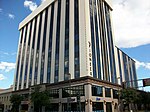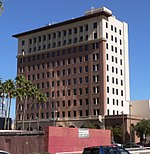Pima County Legal Services Building
Office buildings completed in 1966Skyscraper office buildings in ArizonaSkyscrapers in Tucson, Arizona

The Pima County Legal Services Building is a 20-storey government office building located in downtown Tucson, Arizona. It is the third tallest building in Tucson.
Excerpt from the Wikipedia article Pima County Legal Services Building (License: CC BY-SA 3.0, Authors, Images).Pima County Legal Services Building
North Stone Avenue, Tucson
Geographical coordinates (GPS) Address External links Nearby Places Show on map
Geographical coordinates (GPS)
| Latitude | Longitude |
|---|---|
| N 32.22255 ° | E -110.971049 ° |
Address
Pima County Legal Services Building
North Stone Avenue 32
85701 Tucson
Arizona, United States
Open on Google Maps










